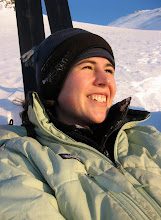Potosi, Bolivia
Here in Potosi, Bolivia life is high-- 4,200 meters high! (That's over 12,000 ft. for all you metric deprived fellow Americans.) Joshua and I have spent the last several days, a little winded, in the highest city in the whole world! But surprisingly, we didn't come to Potosi for the altitude, we came for the disturbing and magnificent story of the mountain towering above.
Once yielding thousands of tons of silvers, nearby Cerro Rico (Rich Mountain) served for centuries as a huge source of revenue for the Spanish crown. But now instead of yielding, Cerro Rico seems to take. It takes the many indigenous men who spend their life eking out a living by mining zinc, tin and copper -- the lucrative silver veins long-since dried up.
The result is a historic city brimming with intricate churches, cobble stone streets, colorful house, and also a disturbing contemporary social reality.
When sitting under the sun, on top of a bell tower, sipping coffee, the charm of Potosi dominates. However, when being led by our guide, a female with short black hair and gold pearl earrings, through a dark and toxic underground labyrinth, Potosi seems like it was created by to El Tio-- the devil-like figure said to rule the mines.
In exchange for gifts of coca leaves, soda and cigarettes, the miners pause for a few moments and share a bit about their day-to-day lives. Both the guide and the miners are frank.
"The average life expectancy is 40."
"Instead of eating breakfast and lunch we chew on coca leaves... about 30 grams a day."
"It takes me three hours to chisel out a 40 cm. meter hole for the dynamite."
"Instead of working 14 hours today, I'm going to work 7 hours tomorrow (a Sat.)"
"There's several hundred children working in the mines"
After nearly three hours undergound, bumping our heads regularly on the low ceilings, we come upon two men almost ready to blast away part of a wall. We watch as they load the dynamite and light the fuse.
"Run," our guide says. We scurry down the cavern and hide behind a wall. One min. in silence. "Boom!" Another 30 sec. "BOOM!" The whole cavern reverberates. Hurriedly, our guide then leads us this way and that until we emerge into blinding light.
Once again we see the the dry, llama filled mountains which cradles the part colonial, part indigenous city. We see the old mint, now a museum filled with splendid artwork and interesting artifacts. We see the church towers, the town square, the markets. We see the grid of an "orderly" Bolivian city.
Once yielding thousands of tons of silvers, nearby Cerro Rico (Rich Mountain) served for centuries as a huge source of revenue for the Spanish crown. But now instead of yielding, Cerro Rico seems to take. It takes the many indigenous men who spend their life eking out a living by mining zinc, tin and copper -- the lucrative silver veins long-since dried up.
The result is a historic city brimming with intricate churches, cobble stone streets, colorful house, and also a disturbing contemporary social reality.
When sitting under the sun, on top of a bell tower, sipping coffee, the charm of Potosi dominates. However, when being led by our guide, a female with short black hair and gold pearl earrings, through a dark and toxic underground labyrinth, Potosi seems like it was created by to El Tio-- the devil-like figure said to rule the mines.
In exchange for gifts of coca leaves, soda and cigarettes, the miners pause for a few moments and share a bit about their day-to-day lives. Both the guide and the miners are frank.
"The average life expectancy is 40."
"Instead of eating breakfast and lunch we chew on coca leaves... about 30 grams a day."
"It takes me three hours to chisel out a 40 cm. meter hole for the dynamite."
"Instead of working 14 hours today, I'm going to work 7 hours tomorrow (a Sat.)"
"There's several hundred children working in the mines"
After nearly three hours undergound, bumping our heads regularly on the low ceilings, we come upon two men almost ready to blast away part of a wall. We watch as they load the dynamite and light the fuse.
"Run," our guide says. We scurry down the cavern and hide behind a wall. One min. in silence. "Boom!" Another 30 sec. "BOOM!" The whole cavern reverberates. Hurriedly, our guide then leads us this way and that until we emerge into blinding light.
Once again we see the the dry, llama filled mountains which cradles the part colonial, part indigenous city. We see the old mint, now a museum filled with splendid artwork and interesting artifacts. We see the church towers, the town square, the markets. We see the grid of an "orderly" Bolivian city.


0 Comments:
Post a Comment
<< Home